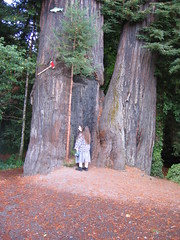The Big Read III: A Tale of Two Cities: Book 1: Ch 4-6

Book 1: Chapter 4 (The Preparation) (some more) (and some more)
The mildewy inside of the coach, with its damp and dirty straw, its disagreeable smell, and its obscurity, was rather like a larger dog-kennel.Ahhh the good old days. I wonder, was it much the same in Dickens day? I suppose it was, perhaps worse, as this bio tells me he was born "during the new industrial age."
Like an angel of light the young Miss Manette appears.
As his eyes rested on a short, slight, pretty figure, a quantity of golden hair, a pair of blue eyes that met his own with an inquiring look.... a sudden vivid likeness passed before him, of a child whom he had held in his arms on the passage across that very Channel, one cold time, when the hail drifted heavily and the sea ran high. The likeness passed away, like a breath along the surface of the gaunt pier-glass behind her, on the frame of which, a hospital procession of negro cupids, several headless and all cripples, were offering black baskets of Dead Sea fruit to black divinities of the feminine gender--and he made his formal bow to Miss Manette.I wondered about the "negro cupids," and I found this from Stanford. If I have time I'll want to go back and look at that for a deeper understanding. According to that, the carvings were "negro" because the material in which they were carved were black, the better to heighten the gothic gloominess surrounding the pure light of Miss Manette.
So the one recalled to life is her father, and the banker's mission is to tell her, and get her to France to bring the man back.
Thanks to TadMack over at Finding Wonderland for sharing the image.
Chapter 5: The Wine-Shop (continued) (some more) (even more)
Ew. Drinking wine from the offal-filled street. Ew. They did that? May I never be so poor. May no one be so poor.
Back in France we meet the woman who knits, the wine-keeper's wife.
Madame Defarge being sensitive to cold, was wrapped in fur, and had a quantity of bright shawl twined about her head, though not to the concealment of her large earrings. Her knitting was before her, but she had laid it down to pick her teeth with a toothpick. Thus engaged, with her right elbow supported by her left hand, Madame Defarge said nothing when her lord came in, but coughed just one grain of cough.Chapter 6: The Shoemaker (continued) (some more) (yet more)
So just how necessary was the continued locking up of Mr. Manette? His former servant took care of him, yet made a show of him. His dark surroundings, his small cell, making of shoes, were these necessary? This is most slippery for me with my modern sensibility. I know the mad were not treated well by the establishment, but I wonder, what about the common folk. What did they usually do to take care of the mad? More to the point, did Mr. Defarge treat the old man with compassion, or with spite? He certainly willingly helps the foreigners pack for the shoemaker.
Again Miss Manette is the light angel in the darkness. Her golden hair, matching his long-saved treasure, is the thread that pulls the man from his dark world.
Read what others have to say.




1 comment:
It's so cool that you're linking directly to the chapters!
I think the reason Defarge kept M. Manette locked up was because M. Manette got panicked if he wasn't.
I do think it was sketchy that he showed him off to other people. I think Defarge was using him as a symbol, an example of what needed to change in France, but I could certainly be wrong about that. Still sketchy, though.
Post a Comment